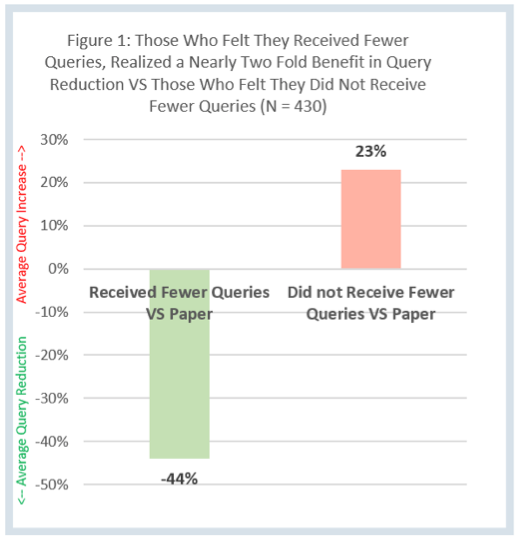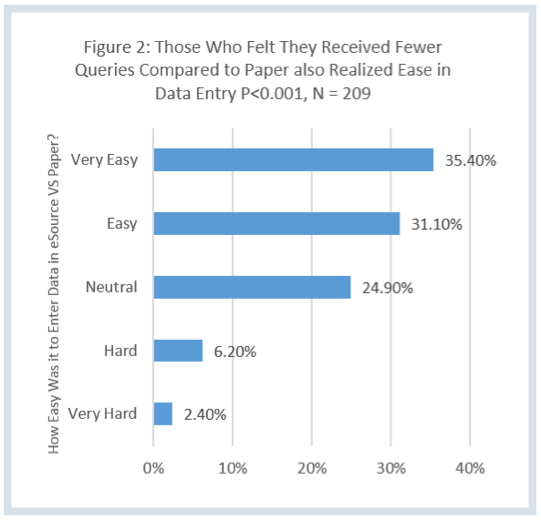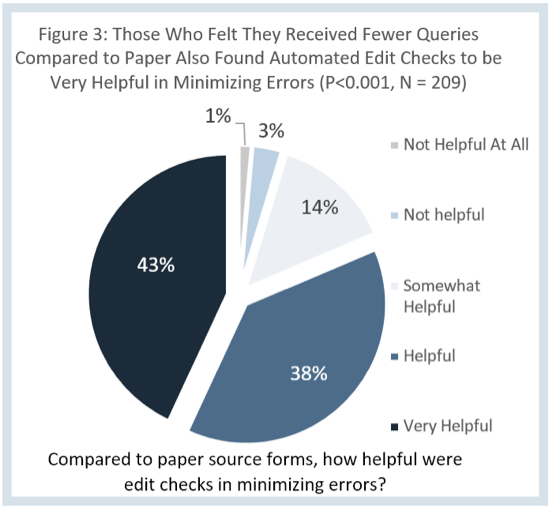Study Shows eSource Can Improve Clinical Trial Data Quality
The Site Impact Survey was designed by Clinical Ink to evaluate clinical research coordinator and investigator experiences with Clinical Ink’s eSource system compared to paper source.
Since the FDA released its Guidance Document on Electronic Source (eSource) Data in Clinical Investigations in 2013, sponsors and study sites are starting to adopt and gain experience using eSource as a method of collecting data in clinical trials. These new experiences are now providing insights on how eSource is affecting clinical operations.
In a recent article, we leveraged Clinical Ink’s Site Impact Survey to evaluate the impact of eSource on workload reduction at study sites. This article will go deeper into Site Impact Survey data to study the effect of eSource on those who experienced query reductions on factors such as data quality.
Site Impact Survey
The Site Impact Survey was designed by Clinical Ink to evaluate clinical research coordinator and investigator experiences with Clinical Ink’s eSource system compared to paper source. Clinical Ink issued surveys to 2,402 research coordinators and investigators who have used eSource in clinical trials, and received responses from 517 eligible individuals. The survey asked questions about comparing differences between paper-based studies and trials using eSource. We leveraged multifactorial statistical assessments, and confirmed statistical fit via chi-square models in this analysis.
The Impact of eSource on Query Reduction
When asked about whether using eSource reduced the amount of queries compared to paper methods, the opinion was split in half; out of 430 respondents (who provided a response to the question), 49% felt that using eSource received fewer queries, whereas 51% indicated that using eSource did not. Correspondingly, we evaluated opinions associated with these differences, and observed that those who felt eSource reduced the amount of queries also realized a nearly twofold average reduction (-44%) in queries compared to those who did not experience a reduction in queries (23%), as delineated in Figure 1.

It is possible that this opinion is experientially based; to elaborate, it conceivable that those who found benefits in using eSource technology systems and methodology may have also had significantly more positive affectations with using eSource compared to those who did not realize benefits, or were uncomfortable with using new clinical trial technologies and methodologies.
Impact of Query Reduction on Data Entry and Quality
In a previous article, we discussed how eSource eliminates the process of transcription from paper to electronic data capture (EDC) and streamlines data entry via direct electronic system input. After delving deeper into the data, we discovered that those who perceived fewer queries when using eSource also realized ease in entering data into eSource technology compared to paper forms (Figure 2).

Figure 3 below illustrates that those who perceived less queries with entering data directly into eSource technology also realized that automated edit checks were helpful in minimizing data entry errors, and subsequently improving data quality.

Impact of eSource on Data Quality
The aforementioned findings led us to further investigate the impact of eSource methodology and technology on data quality by interviewing Donna Straatman from Mercy Health System. We asked Straatman about her experiences (with regards to data quality) in using eSource compared to paper, and she indicated, “with eSource, you can’t really miss data and go forward not collecting it; you have to complete the forms. The green check marks on the forms tell you that you’re done. With paper, it’s a pain to have to enter data into EDC, receive automatic queries, and then have to go back in the future to fix things. With eSource, it really helps to have the immediate ability to correct data on the spot.”
Dr. Leonard Chuck, MD, PhD of Diablo Clinical Research resonated by stating, “through a validated environment, eSource prompts quality by preventing sites from writing and amending the source, guiding sites through properly sequenced visit procedures, guaranteeing the collection of all endpoint data, and allowing investigators to pull down evaluation criteria preceding an evaluation.”
Hindrances for Adoption: Culture
While it is clear that the benefits of using eSource as a methodology and technology offers benefits, as delineated by FDA’s Guidance Document on eSource, many clinical trial personnel are still hesitant. I have recently been involved with executing clinical trials at several medical institutions, and attempting to convince CRAs to leverage eSource, (while eliminating data collection through paper CRFs) has been a tough task. To demonstrate, CRAs exhibited comfort with generating more source documents, and could not envision clinical trial execution without paper source and source document verification. Unfortunately the traditional source method not only creates burdens at study sites, but also affects data quality and is resource exhaustive.
A Call for Innovation
It is advisable that management at Sponsors mandate, through initiatives and technology pilots, that eSource be deployed in clinical trials. While real-time data entry access and resultant improvements in data quality can assist significantly with centralized and risk-based monitoring efforts, study sites will experience the biggest impact, which enables study staff to focus on more important trial tasks, such as enrollment efforts, and spending more time with the patient.
“eSource technology is reliable, accurate, trustworthy, and exciting. We were initially a little nervous about whether it was going to work and whether the data was going to be there because we are trained to put everything on paper, but, once we started using eSource technology, it was a very friendly system; it is user-friendly, easy to navigate, and I can pull patient conmeds. I also feel reassured that the information we put in there is accurate, especially if we undergo an FDA audit,” added Staatman.
Click here to view the full whitepaper on the results of the Site Impact Survey